|
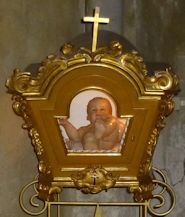 Dwight Peck's personal website Dwight Peck's personal website
Sicily in December 2012
On the track of the Carthaginians, Greeks, Romans, Arabs, Normans, French, Spanish, Italians and Commissario Montalbano
You may not find this terribly rewarding unless you're included here, so this is a good time for casual and random browsers to turn back before they get too caught up in the sweep and majesty of the proceedings and can't let go.
A few more exciting days in Palermo
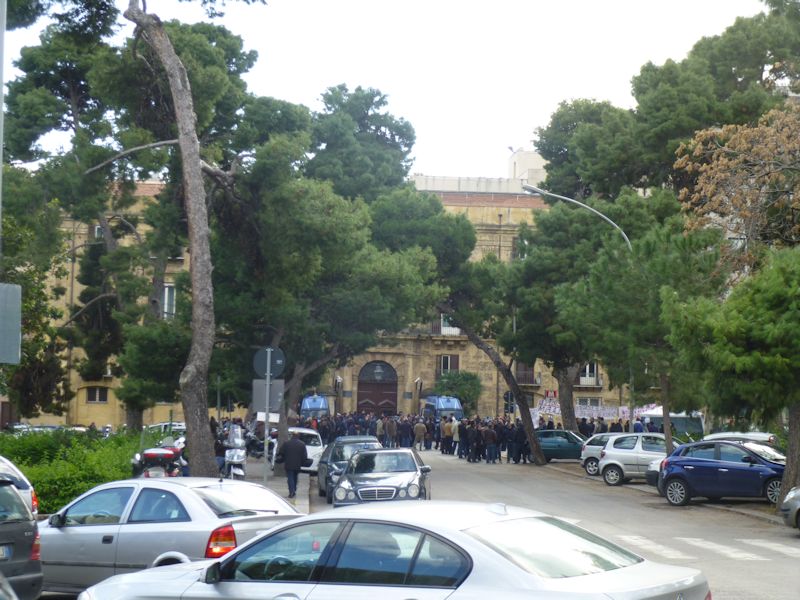
The workers have had enough, and about time, too. It's a small permanent workers' protest just north of the Norman Palace.
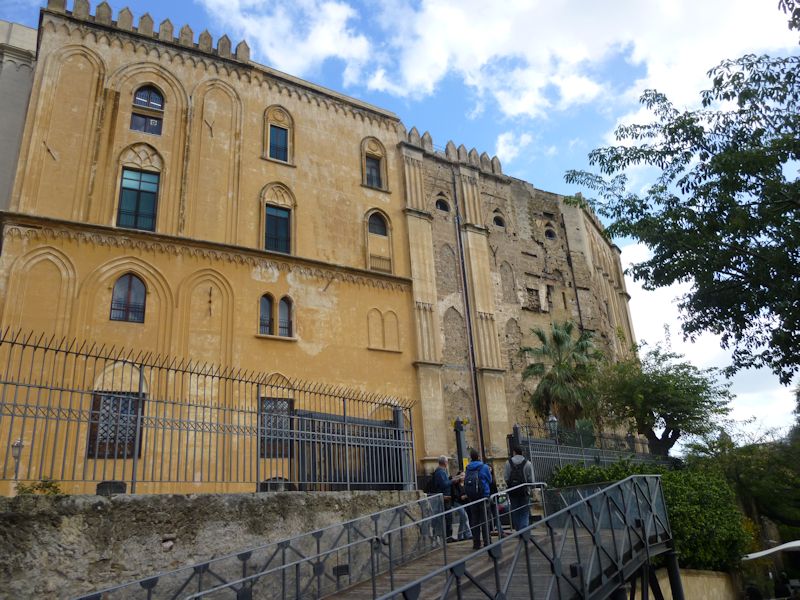
The Palazzo dei Normanni, or Royal Palace, Palermo's must-see destination -- it's now the premises of the Sicilian Parliament as well, so don't wander off down the corridors.
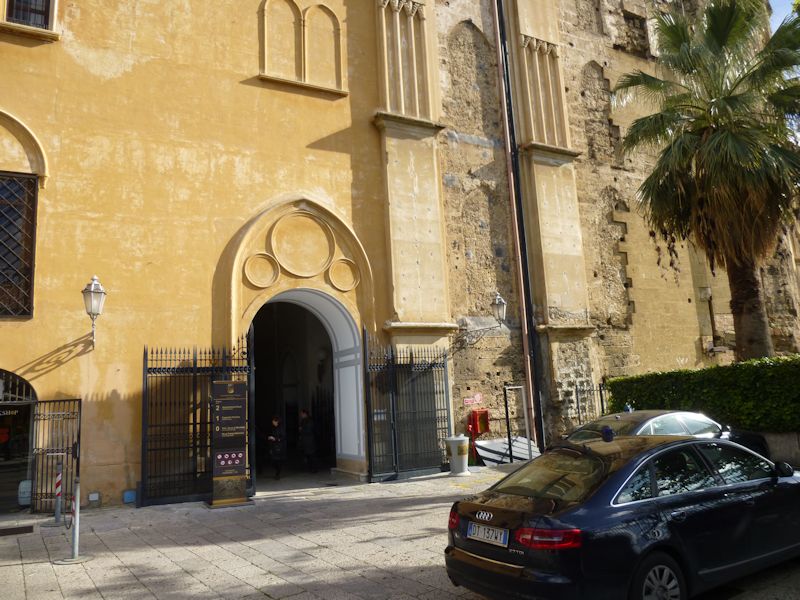
At 9 years old, Roger II, Count and then King of Sicily, inherited from his father Roger I the palace built over an Arab fortress at the high point of old Palermo, and it's served as a seat of Sicilian government, one way or another, ever since.
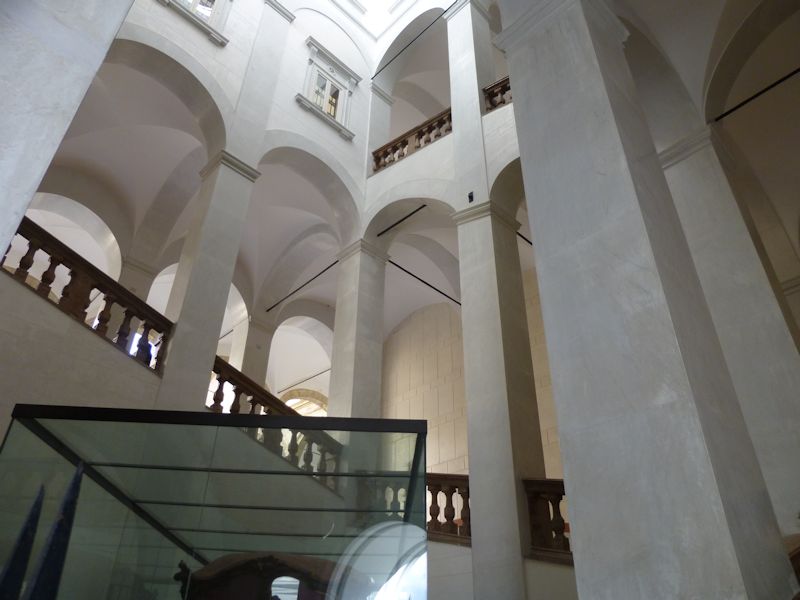
It's got lots of nice royal apartments with neat furniture and lots of people in uniforms running round yelling "No Photo", but the cynosure is the Cappella Palatina, or Palatine Chapel, which Roger built from 1130 onward.
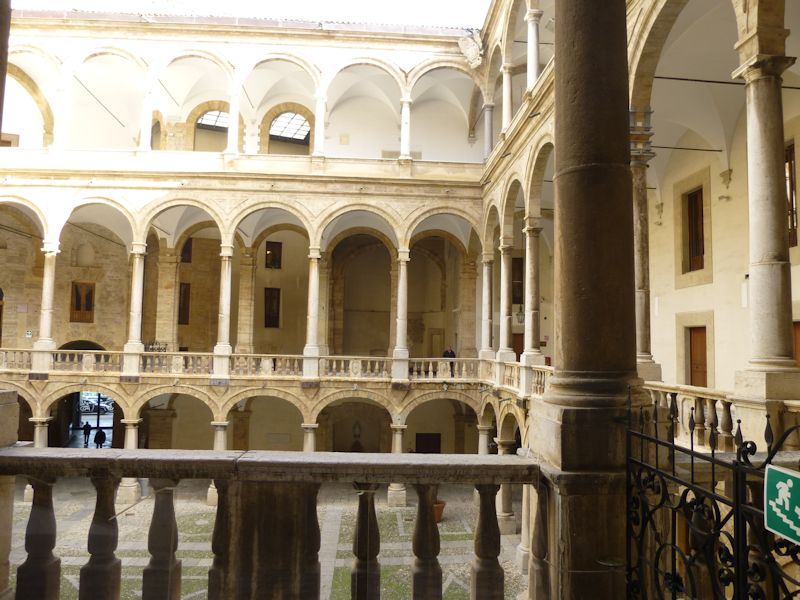
Roger II was known as a grand lover of all the Mediterranean cultures of the time and welcomed western Christian, Byzantine Christian, Jewish and Muslim artists and scholars, in an efflorescence of culture that outshone nearly all of Europe of the time, whilst he was uniting all of the Norman holdings in Sicily, Apulia, and Calabria into one realm and getting himself named King by the Anti-Pope Anacletus.

The central loggia of the palace, on the level with the Palatine Chapel.

The gem-like Palatine Chapel, recently restored, with its huge mass of amazing mosaics done by a crowd of Byzantine Greek artists brought over in 1140 for the purpose.
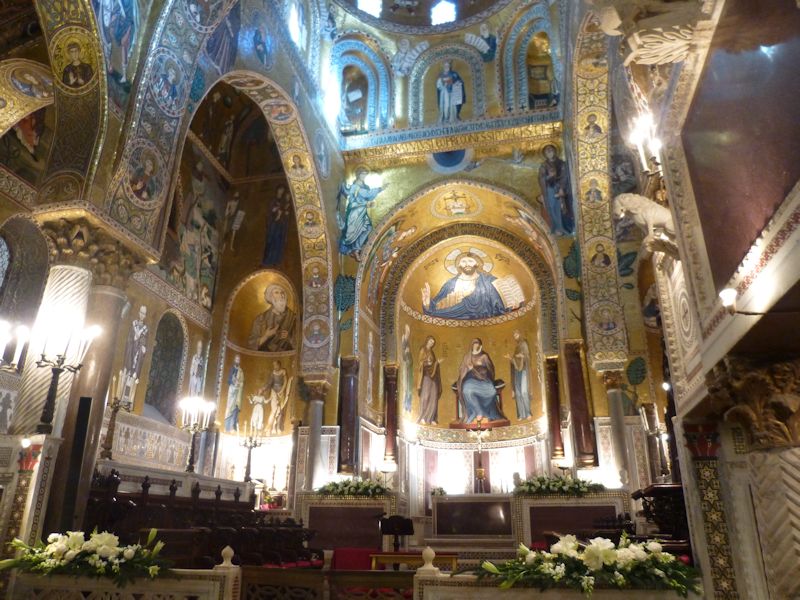
The Saracen arches and the apse, dominated by the triumphant Christ the Pantocrator or "Almighty"
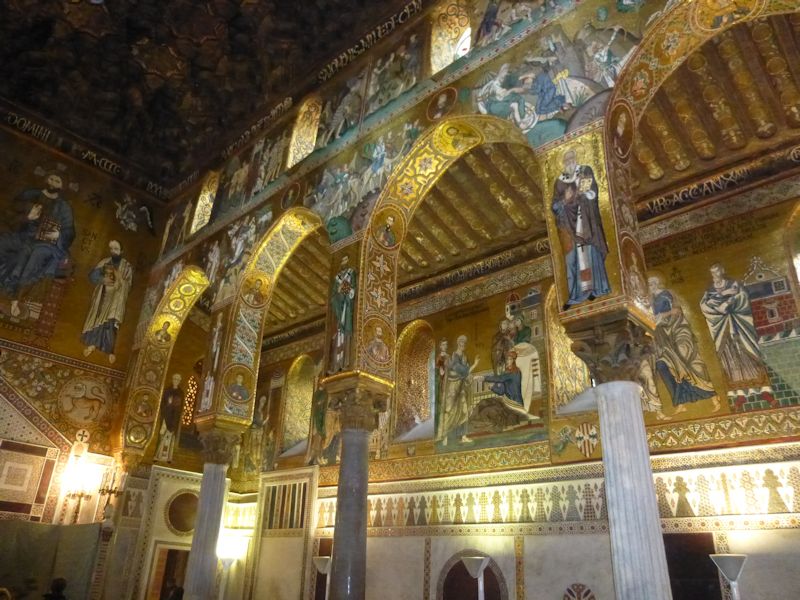
The mosaics in the transept and both sides of the nave, as well as the dome, tell long episodic stories from the Old Testament and the acts of lots of the Apostles, and a few from the Crusades.
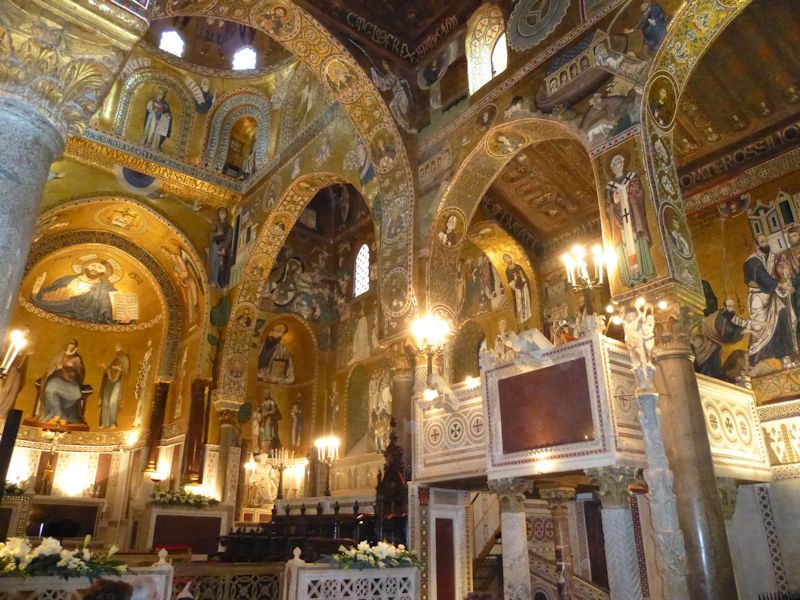
It's really too much. The Islamic influences are all over the building and contributed to the rumors that Roger was secretly a Muslim.
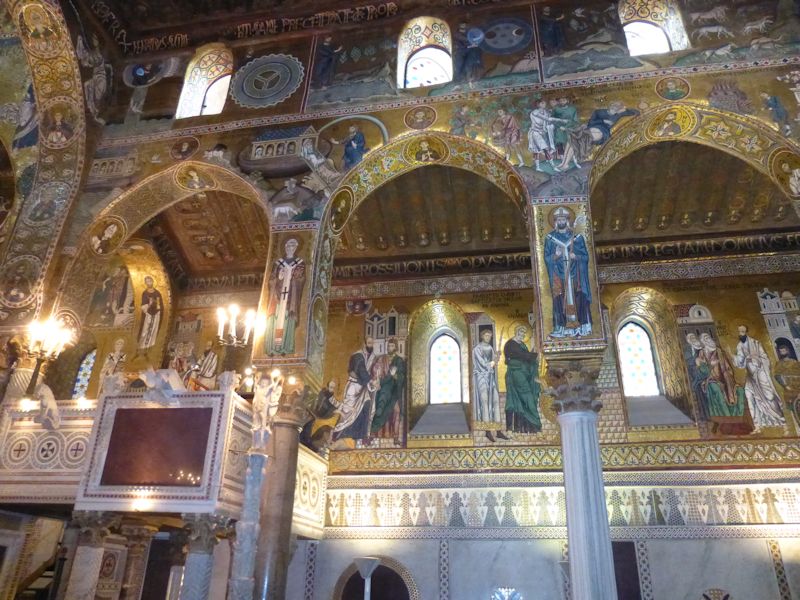
To take in the individual tales properly you'd need binoculars, a well-thumbed Bible, and a day and a half with exclusive access to the building. Nobody now gets more than a general sense of the place.
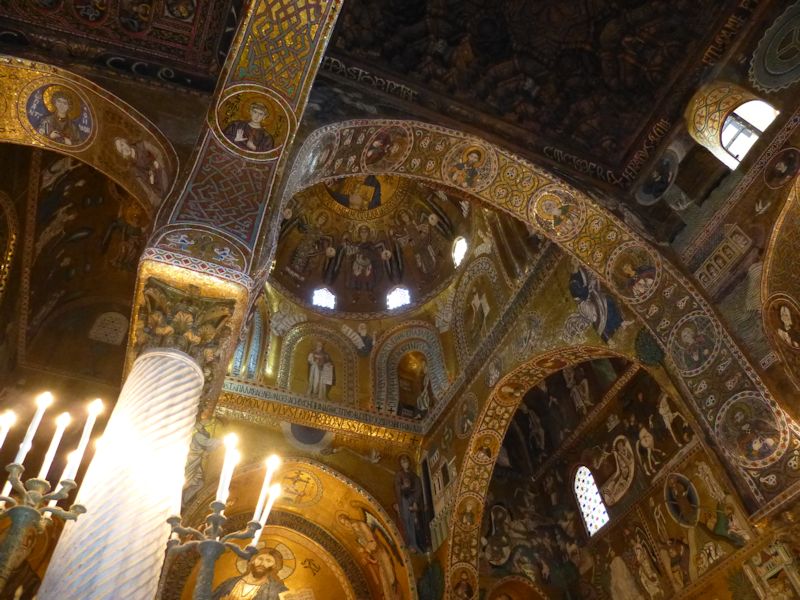

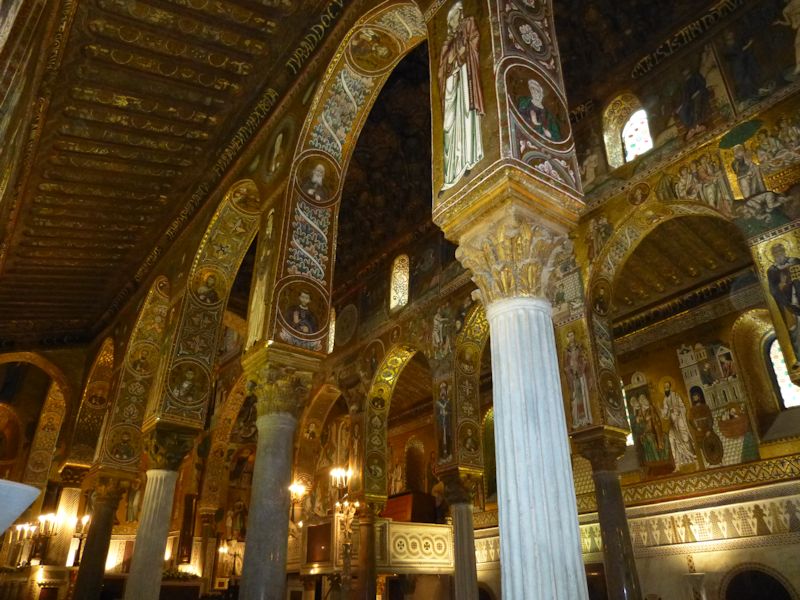
The wooden ceiling is also said to be a masterpiece of Islamic muqarnas honeycomb carving that is unique in a Christian church.
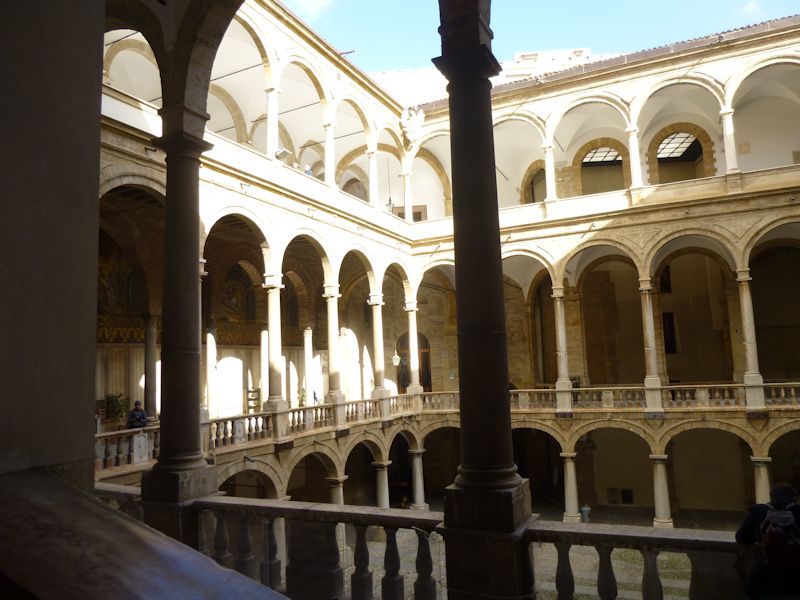
The central loggia just outside the Chapel.
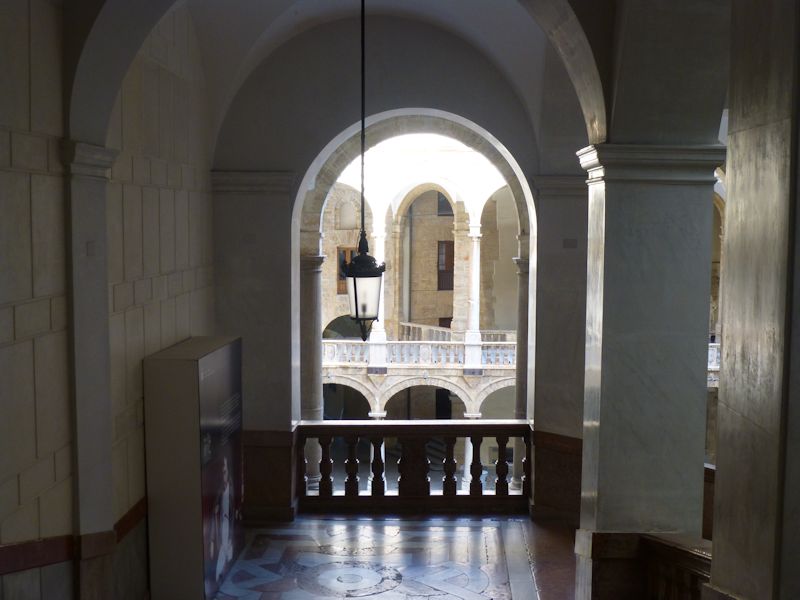
View through arches

The nearby Porta Nuova, built to celebrate the Holy Roman Emperor Charles V's victory over the Tunisians in 1535.
'Compro oro e argento' = 'German bankers moving in for the kill? We'll buy any gold and silver that may be left under grandma's mattress.'
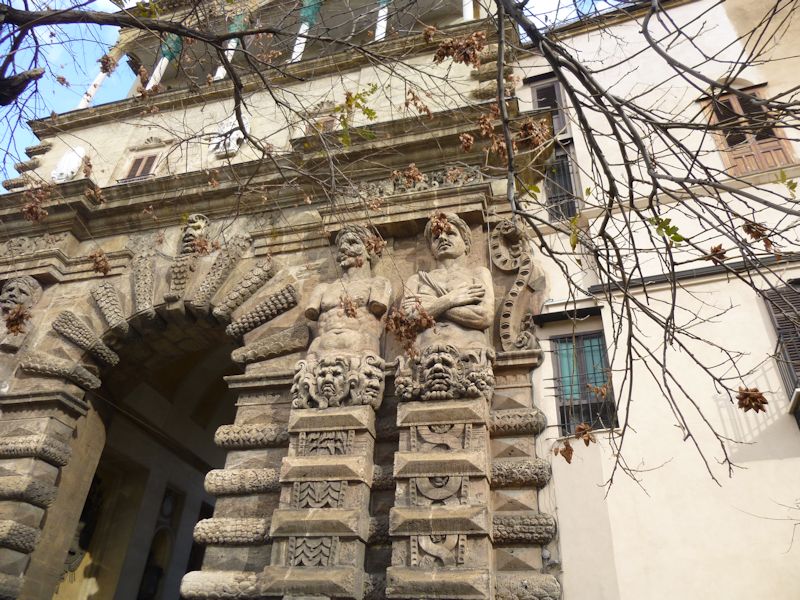
The Porta Nuova
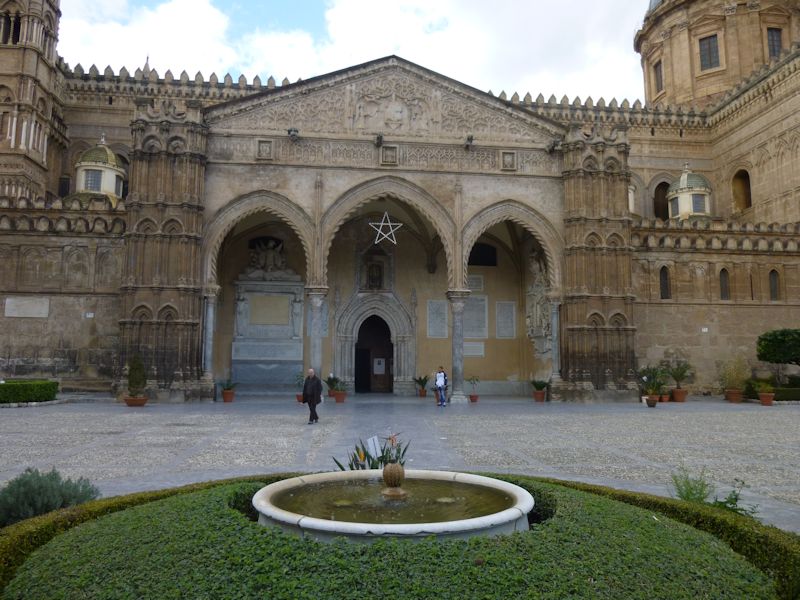
We're back to the Cathedral -- hey, surprise, it's open now.
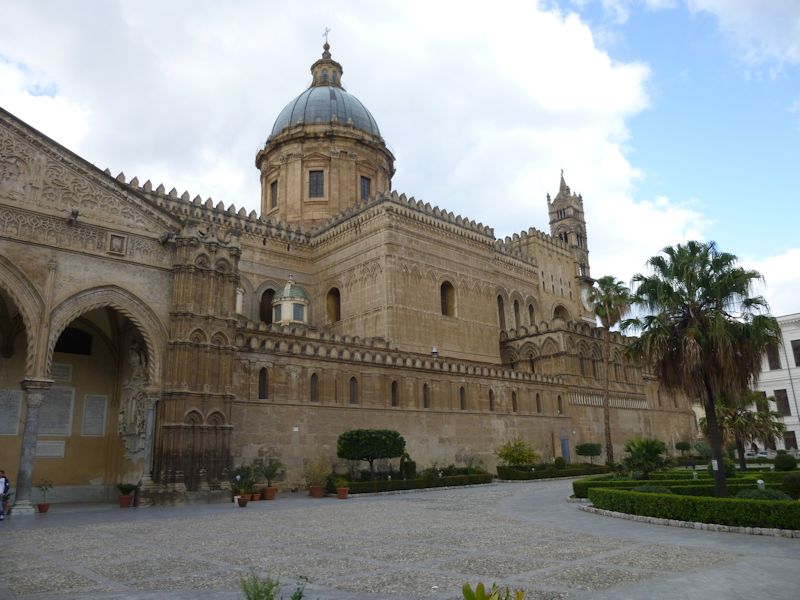
The Duomo of Palermo is another Norman conversion and assimilation of an existing 9th century Arab edifice, begun in 1184 by the English archbishop called Walter of the Mill to show the King (who was building Monreale at the time) that the Holy Church could beat out the King for extravagance anytime.

The archbishop's palace
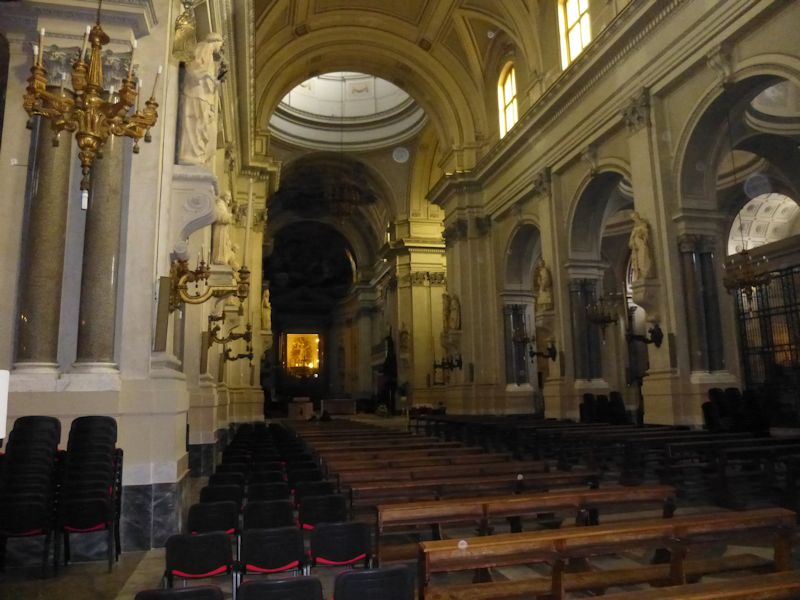
The outside of the cathedral and archbishop's palace is expansive and interesting, but the interior is sort of what Kristin calls "a barker". Woof woof.
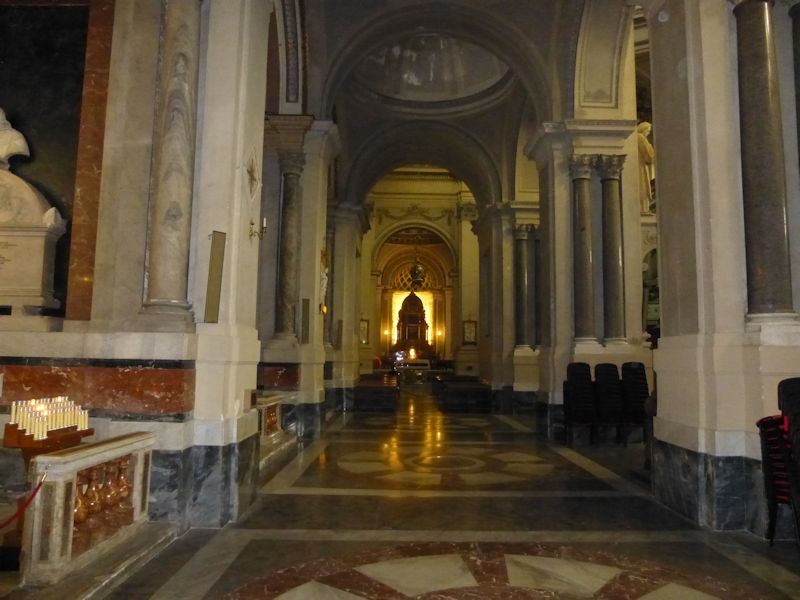
Nice floors
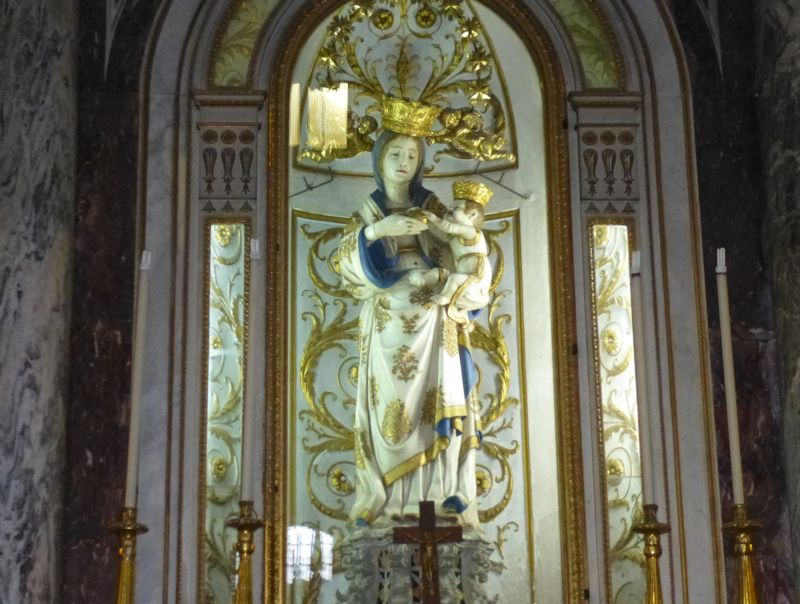
At least we've got the usual Mary and Jesus wearing crowns they could never have held up in real life without the help of their supernatural powers.

The neatest thing about the Palermo cathedral is the dead people they've got stored here -- they've got Everybody (Norman) who's Anybody. That's Roger II himself in there. Jeez!
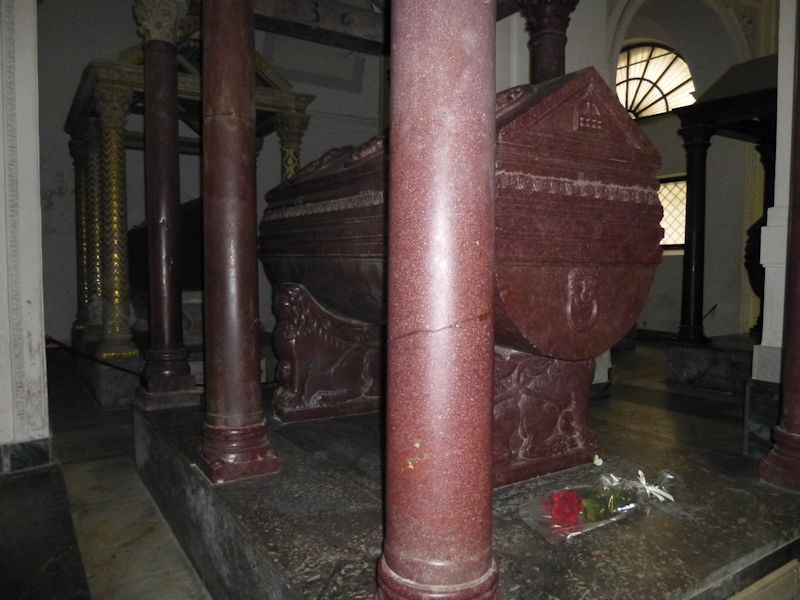
And that -- get ready (ta-dum!) -- is the porphyry home of "Stupor Mundi", the great Frederick II, Roger II's Swabian-German grandson, who died in 1250 (but he's not really dead; he's just sleeping with Barbarossa in the Kyffhäuser Mountains and will someday wake up to free us all and regain his empire).
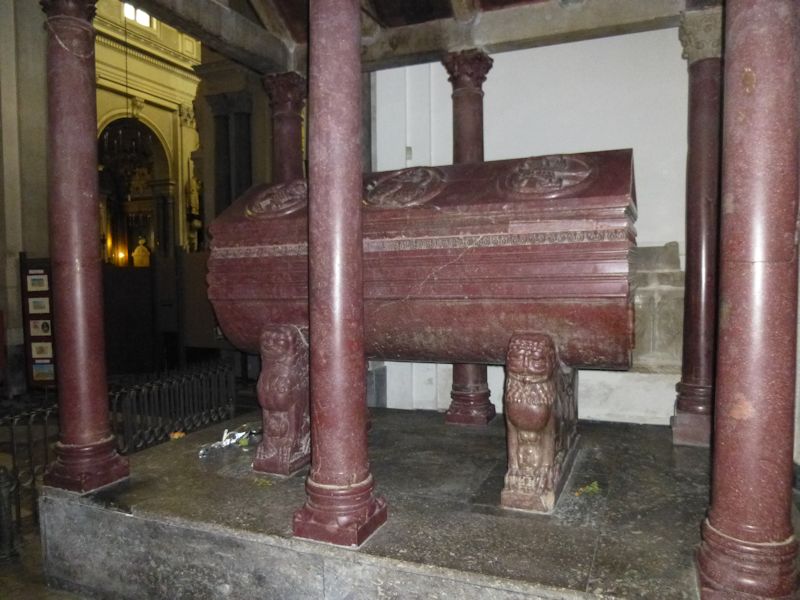
That's Stupor there, but in this cute little alcove (2 euros extra) we've also got Holy Roman Emperor Henry VI, AND his wife Constanza of Hauteville (Roger II's daughter, Stupor Mundi's mom). And more.
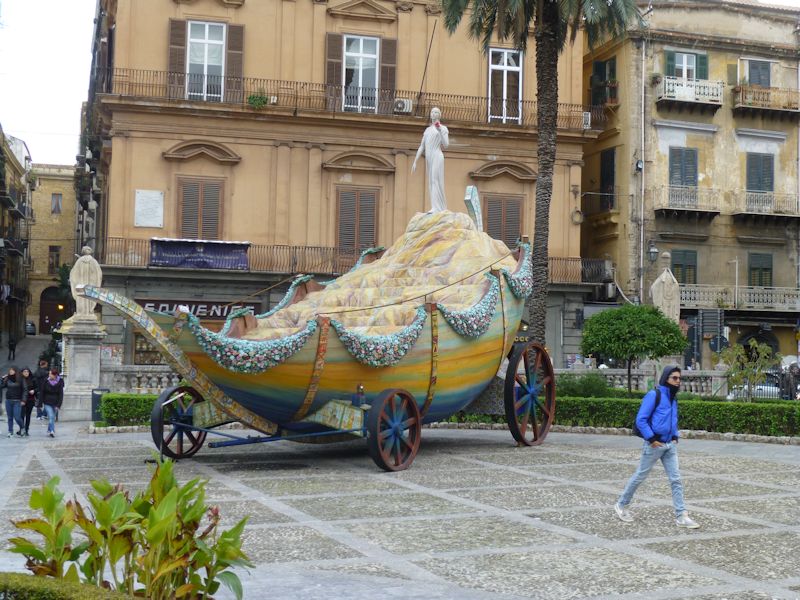
The archbishop's float for the next parade
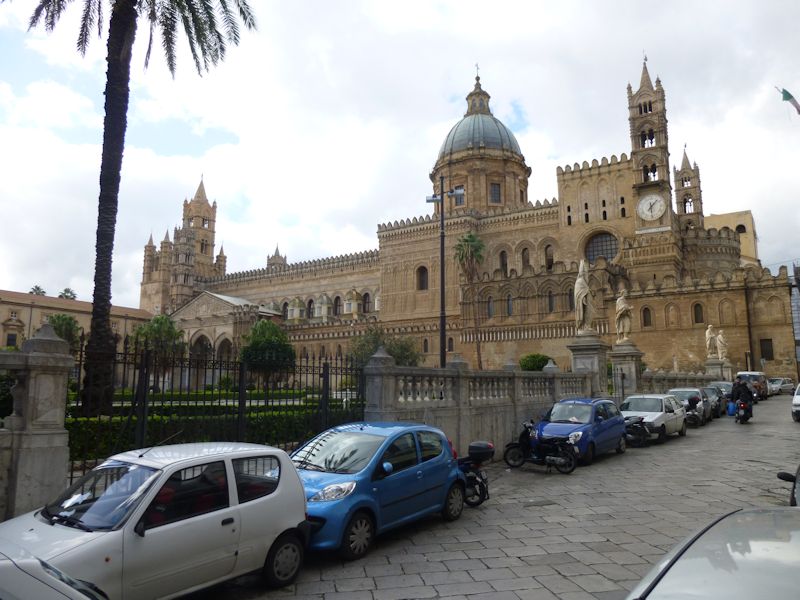
The Cathedral with the crappy dome
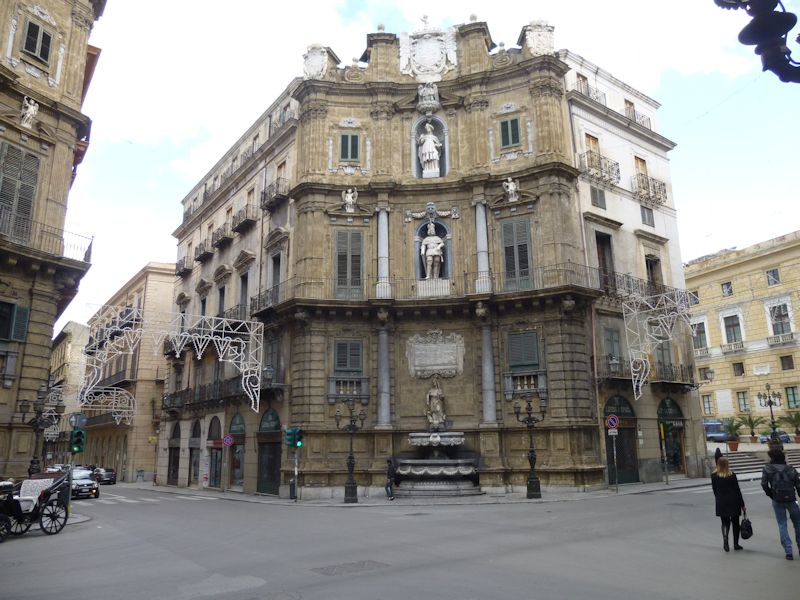
The Four Corners (Quattro Canti), where the central Via Maqueda meets the Via Vittorio Emanuele
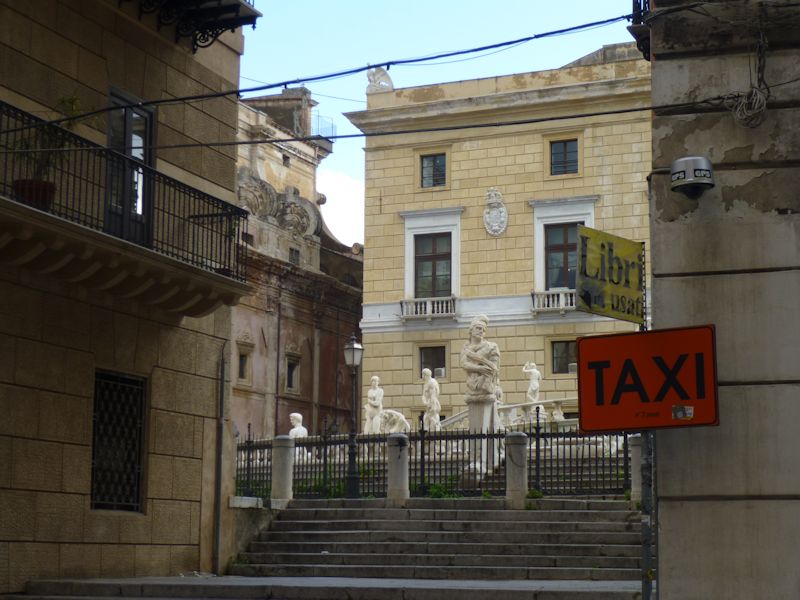
A glimpse of the nearby weird fountain of the Piazza Pretoria (we'll be back for a closer look in a week or two)
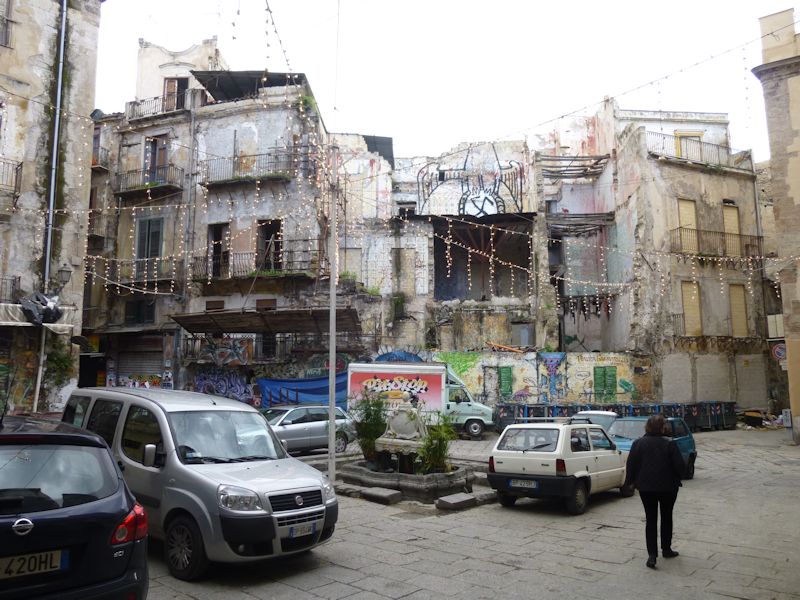
Palermo all decked out with Christmas lights
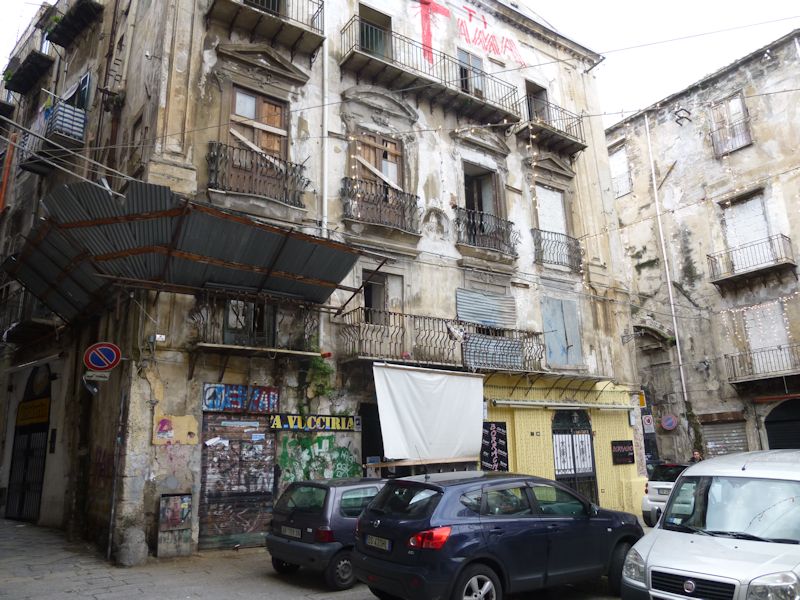
Nothing that a good coat of paint wouldn't fix up nicely. (But the Mafia controls the paint trade.) -- A bad joke there.
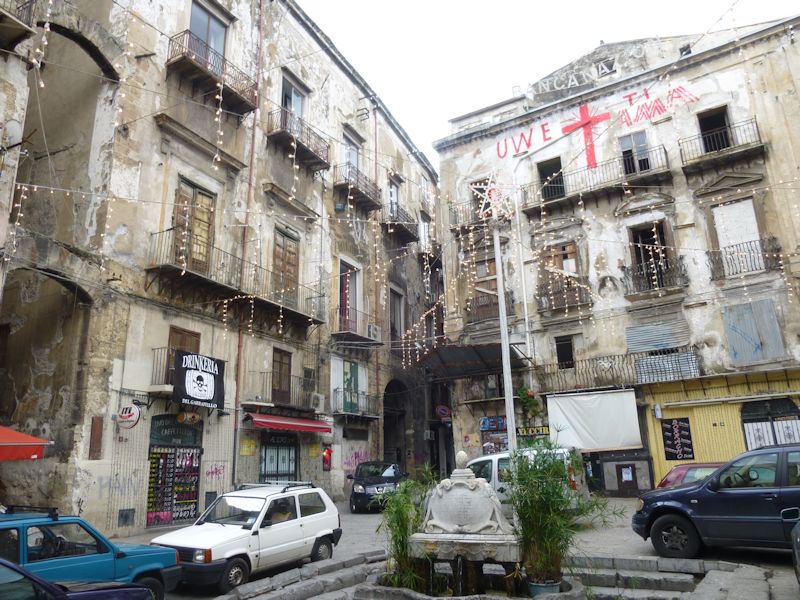
The old Banca Nazionale, and a Drinkeria

Enough for today, we're striding out for home, and another fabulous dinner at our culinary home-away-from-home, the Trattoria Al Vicolo in the Piazza San Saverio (book ahead).
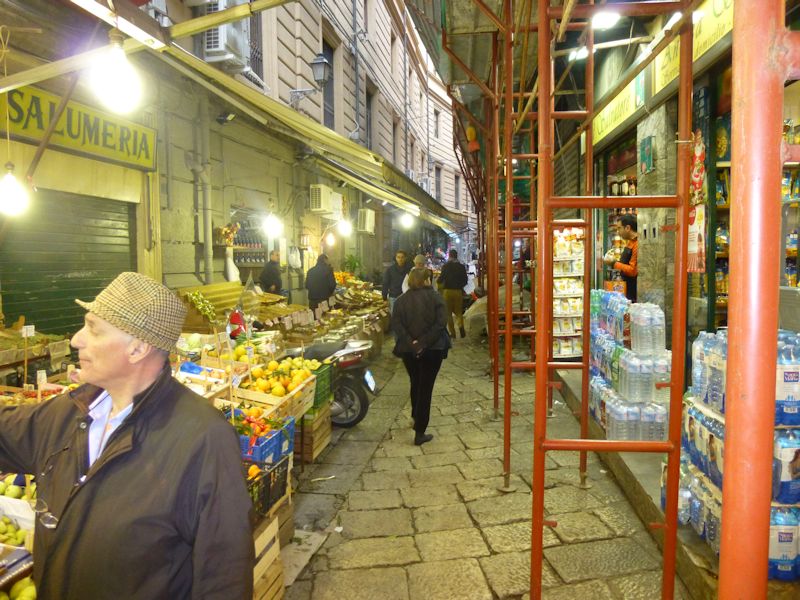
A speculative walk through the markets
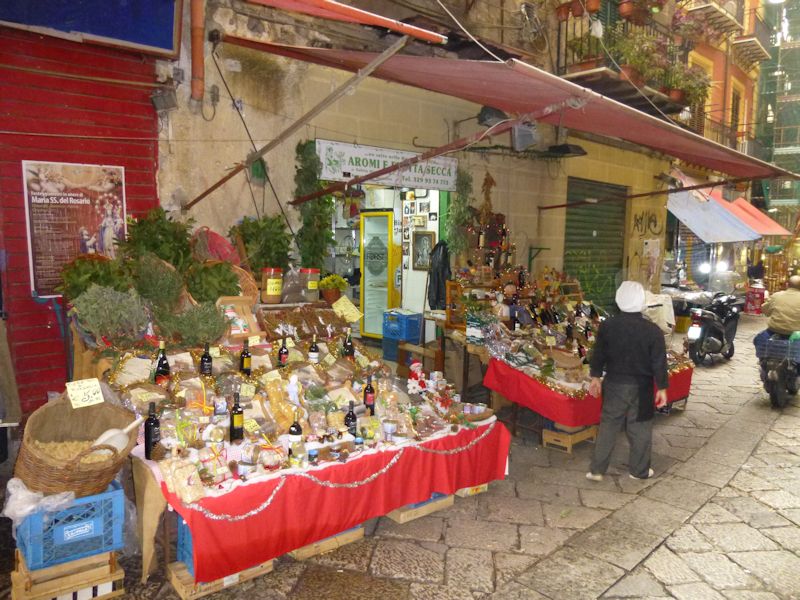
Embarrassment of riches
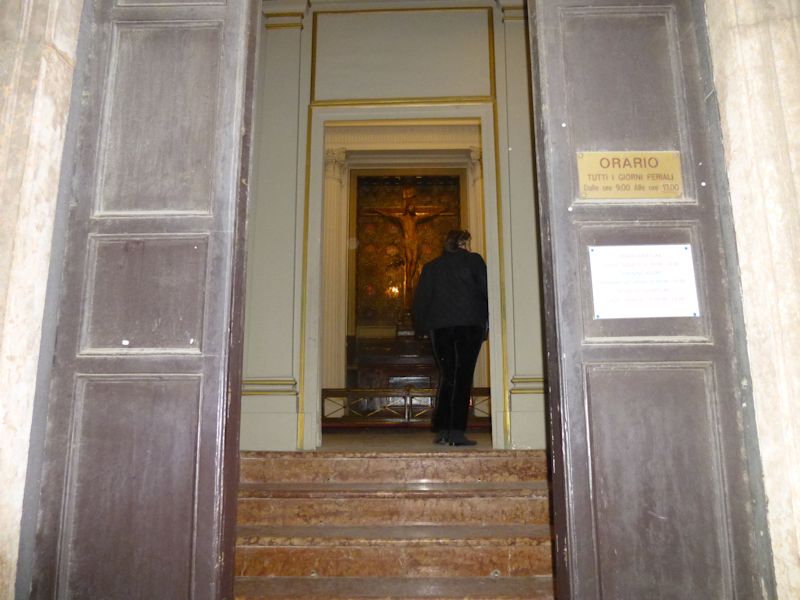
Today's our day for oratorios (not usually my cup of tea).
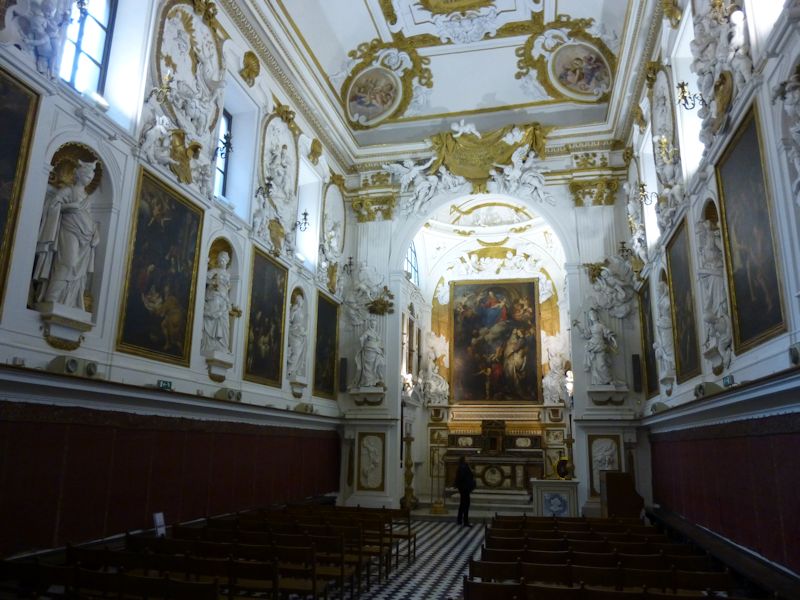
This is why. The Oratorio dei SS. Rosario in San Domenico. Oooff.
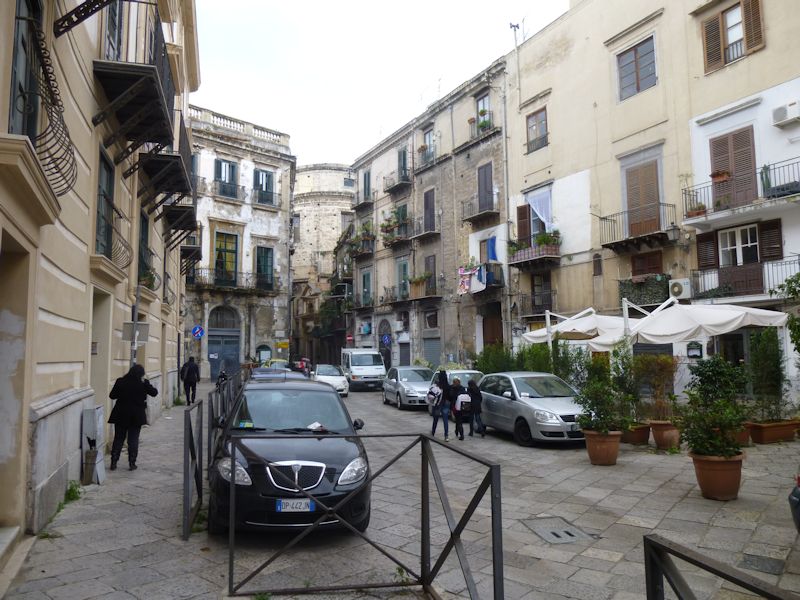
Let's try another one.

It's just up the road here (one ticket covers them both).

The Oratorio of Saint Zita, here we go
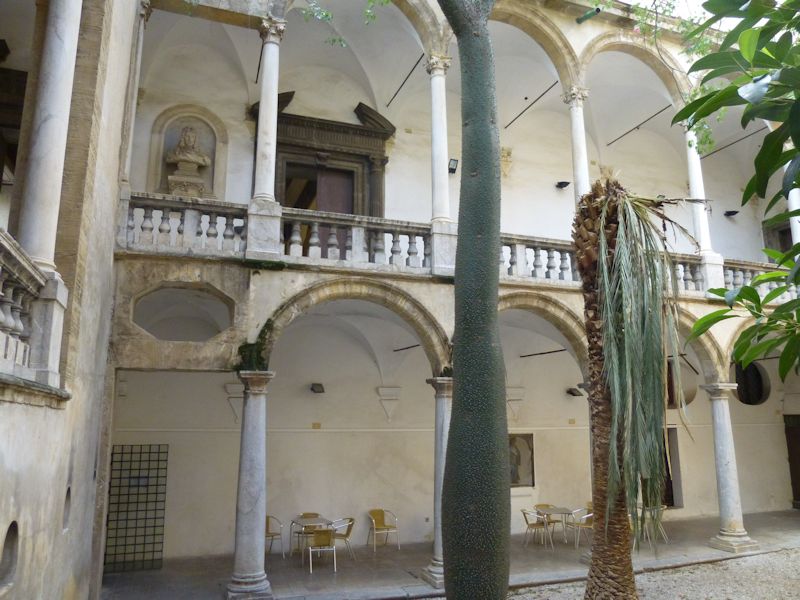
Unnatural trees in the courtyard, for starters
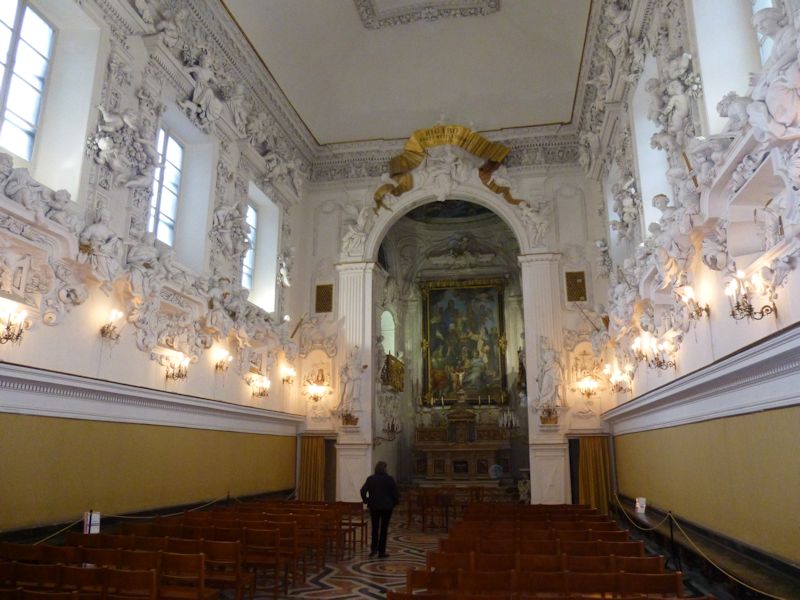
But a lot to catch the eye inside it.
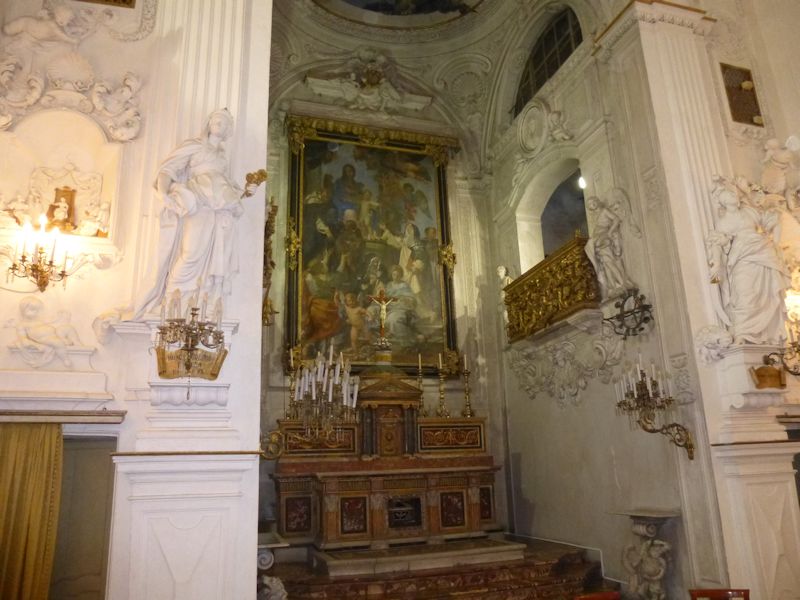
The usual fare in the front of it, but. . .
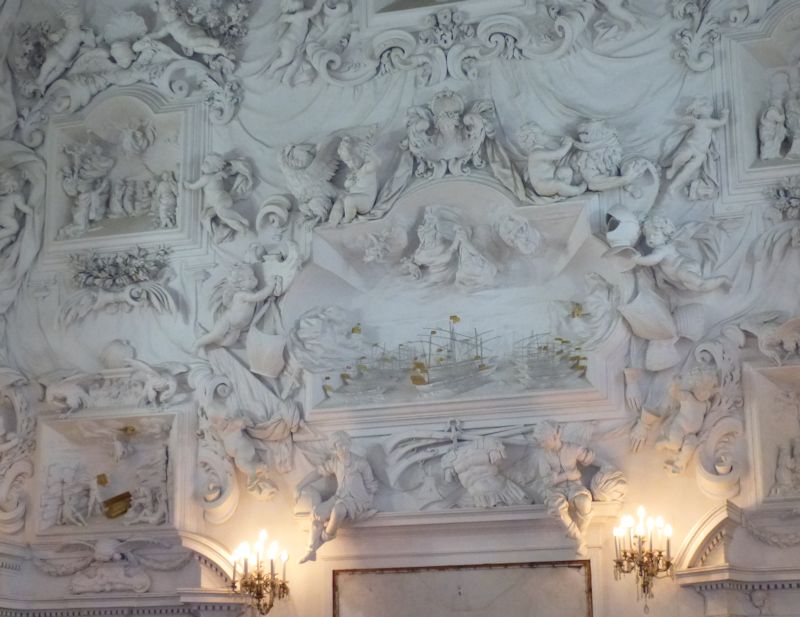
. . . on the back wall, a 3-D celebration on the sea battle at Lepanto in 1571, when the Spanish ended (temporarily) the Turkish threat to Mediterranean Europe. Yay.
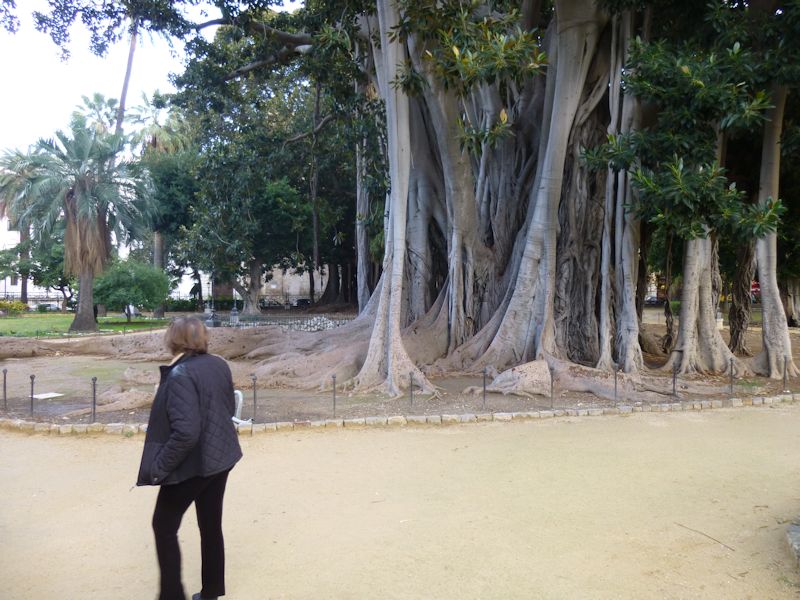
Garibaldi Gardens, down near the port, sports some fine ficus.
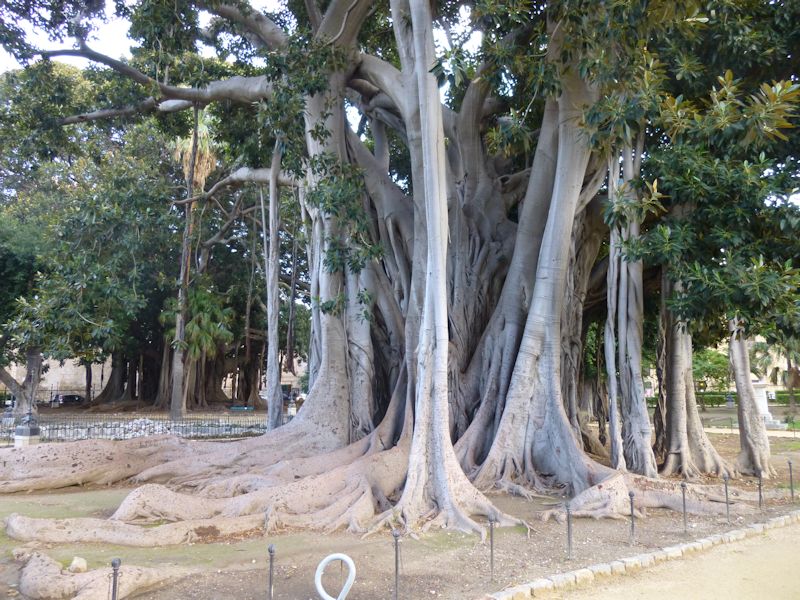
Which, depending on one's upbringing and life experiences, are either a wonder of nature or disgusting.
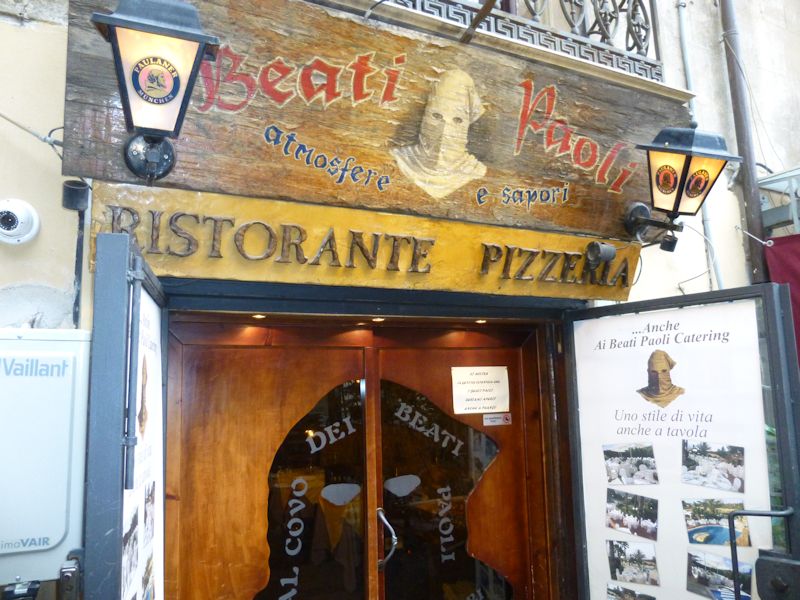
Kristin says it's lunch time -- let's go to a cozy little place near the Giardino Garibaldi dedicated, apparently, to the Ku Klux Klan.

The Beati Paoli is thought to have been a secret medieval society that rose up in resistance to the oppressive landlords and church, and may have been a forerunner of the Mafia society (or so the mafiosi say). The pizza was quite good.
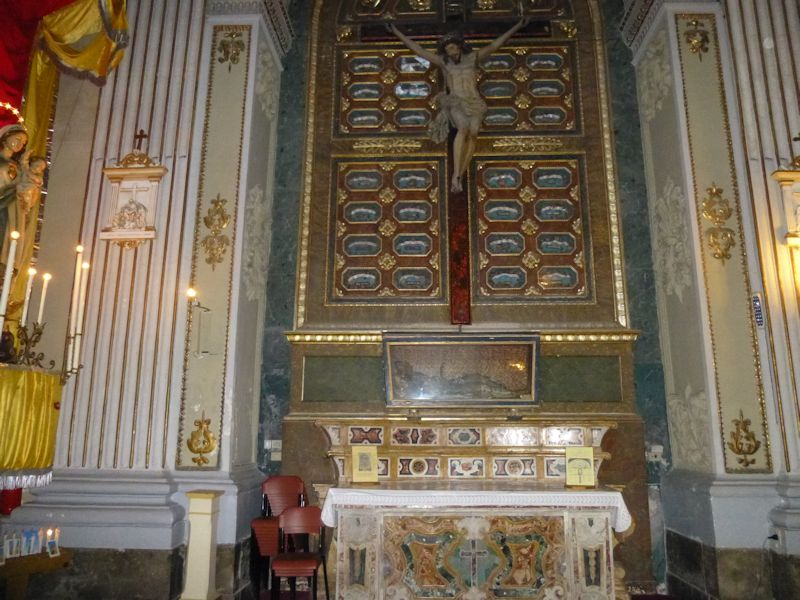
We're in the church of Madonna della Pietà near the port, and here we have still another dead body in glass.
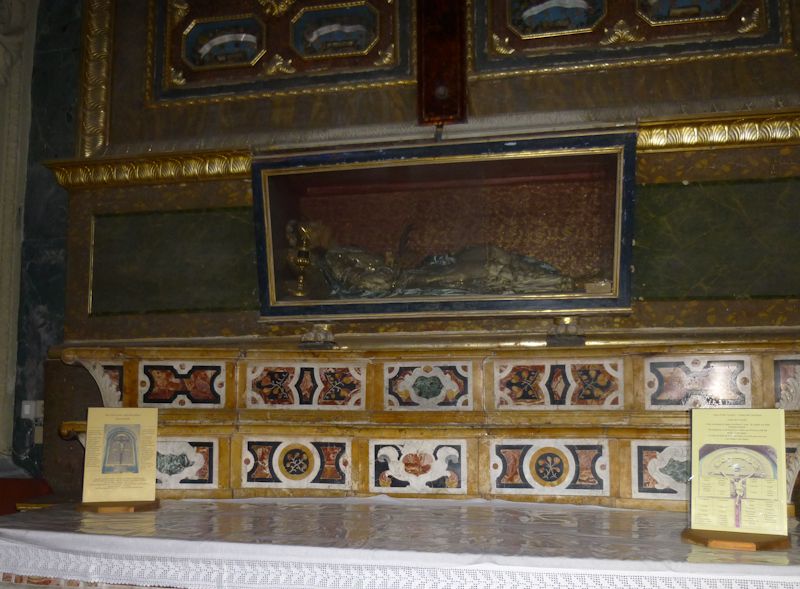
That's evidently Saint Felicita there. Not so felicita now, eh? Or maybe so, up there somewhere.

The Mafia's been here.
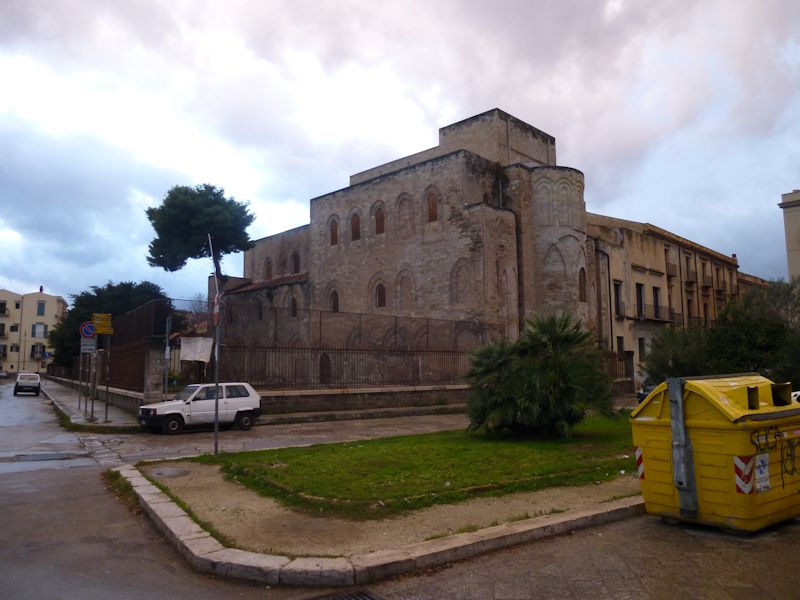
The brilliant Norman Cistercian church of Magione near the port

We've been here twice already to see if it's open, and now it is. Founded in the late 12th century, in 1197 the Emperor Henry VI turned it over to the Order of the Teutonic Knights, so (with the help of the income from sacred properties all over western Europe) Poland, Latvia, Estonia, and Lithuania were facilitated in Finding Jesus, by fire and the sword.
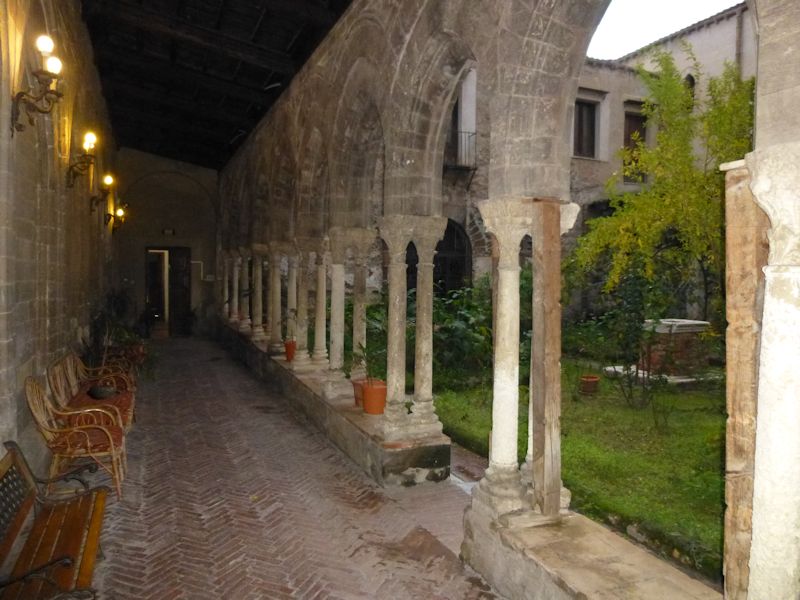
A lovely Norman cloister

A cheatsheet for identifying Jesus's miracles
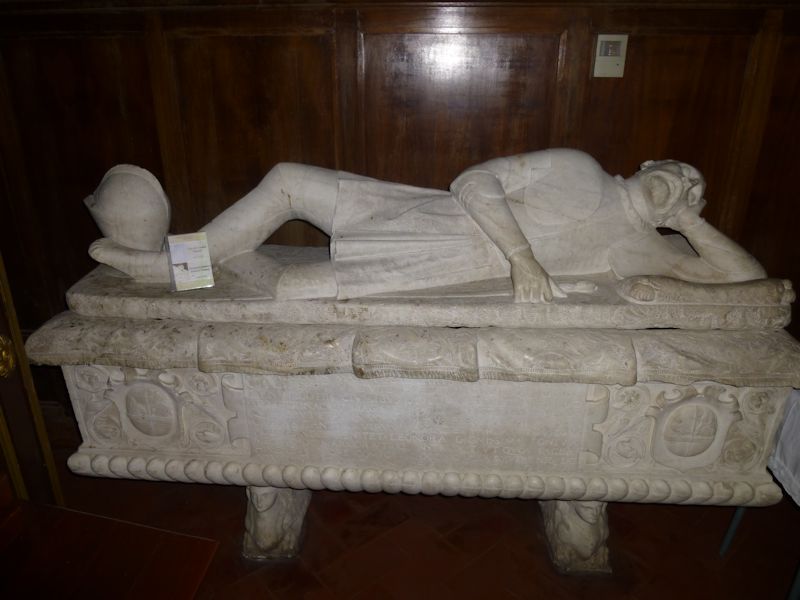
A Teutonic Knight in repose. They were Busy Boys, those Teutonic Knights, and so Christianity came to the Baltic States.
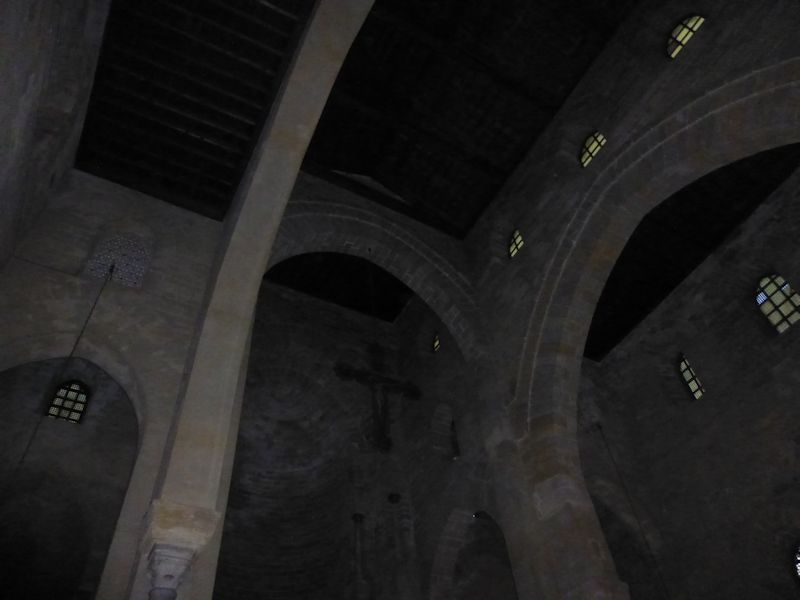
A welcome contrast to 19th century notions of church decor

Oh no! Not that, too!
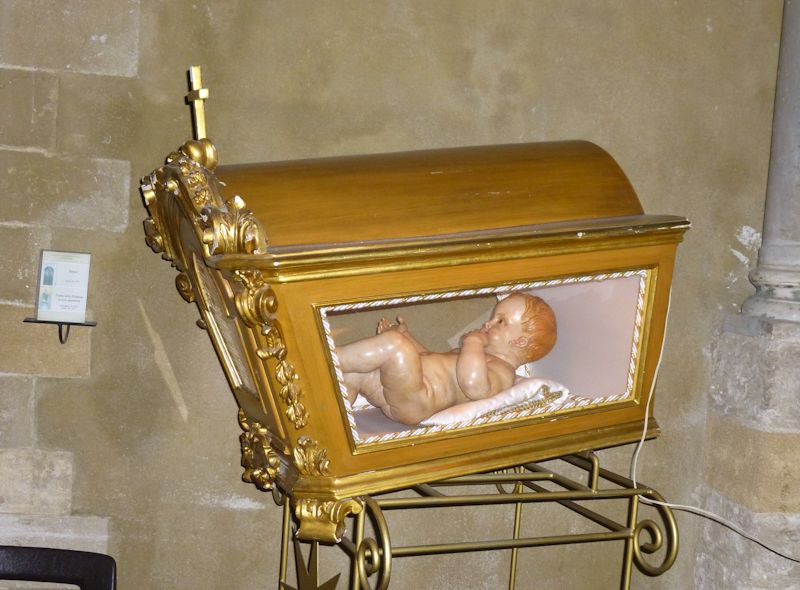
It's only a little dolly, oof.
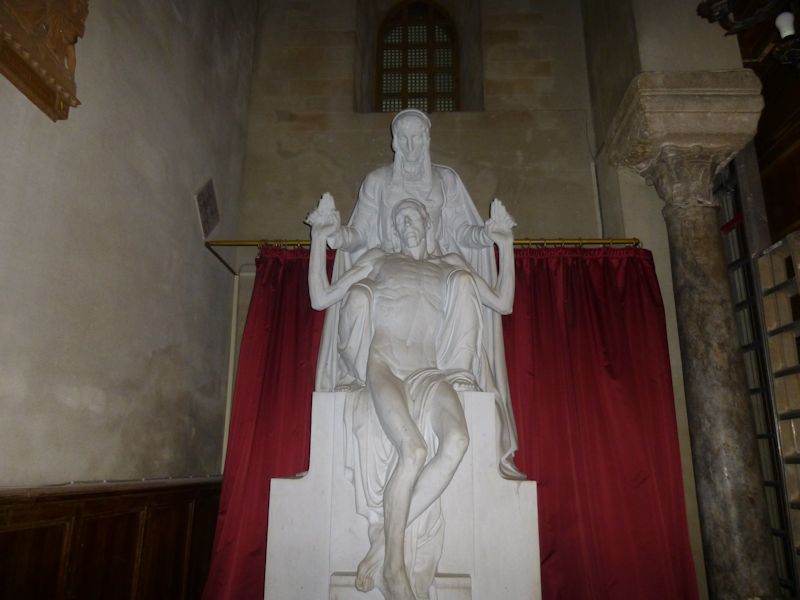
Jesus and his mom
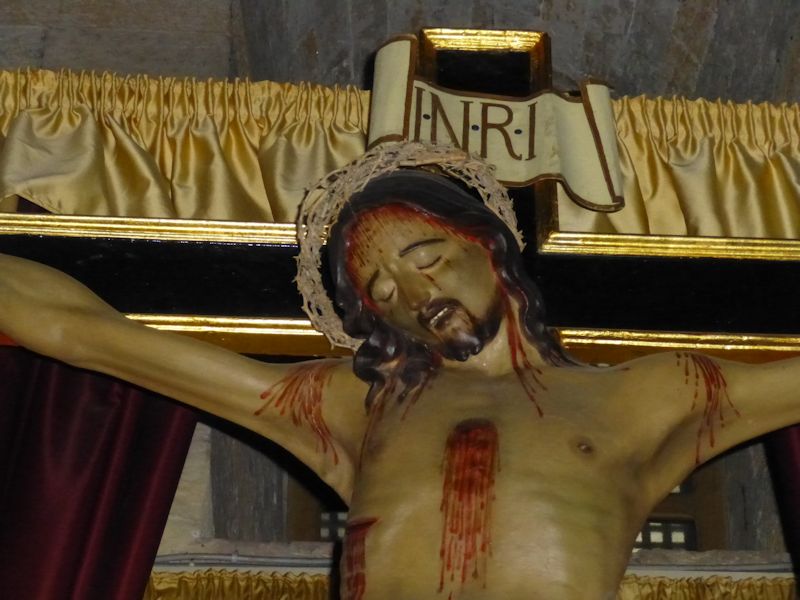
Christus Triumphans, or rather, that's the other Christus: Christus Victimus.

It must be Kid's Night at the old sanctuary

It's the street of Bicycles -- they're all here for the next two blocks.
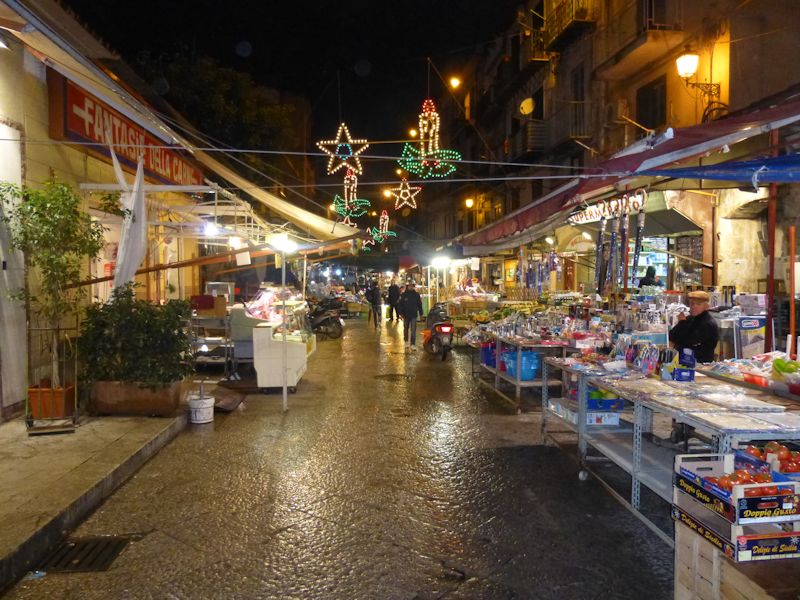
Back into the markets, and the Fantasy of Meat shop on the left.
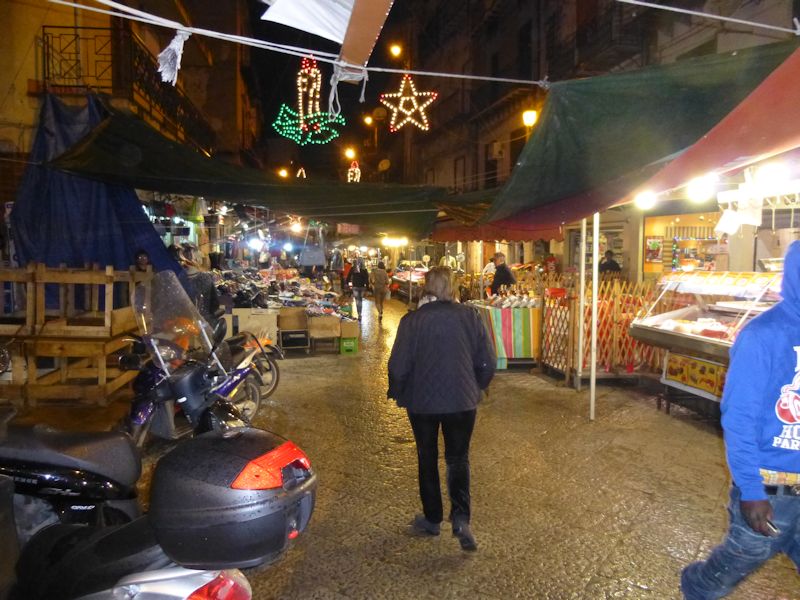
Kristin loves Christmas bargains.
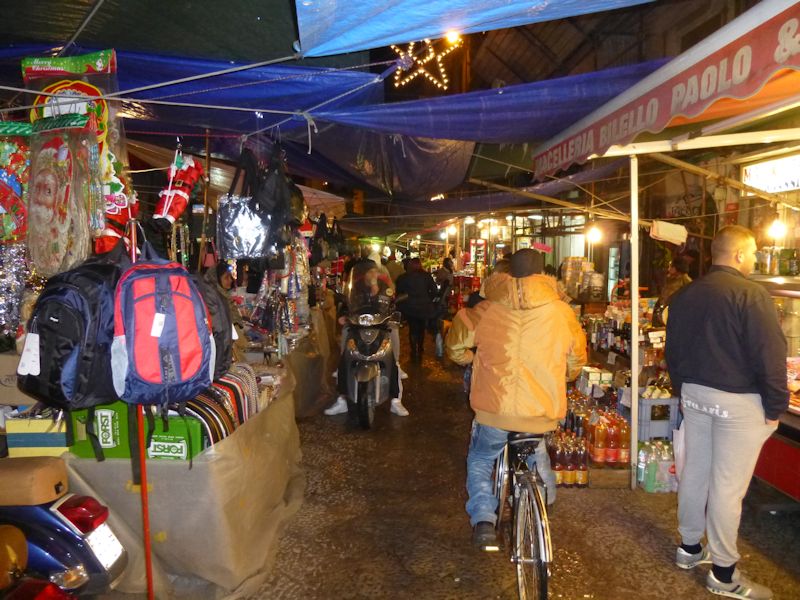
Everybody loves a Christmas bargain.
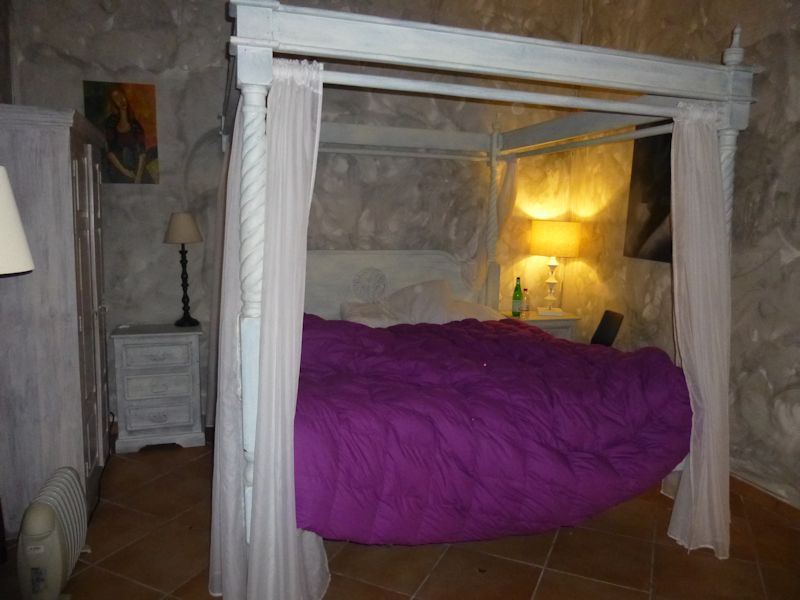
Back to the B+B Porta di Castro. Splendid staff, an ample fruit-dominated breakfast, low prices.
And tomorrow, we're en route for the Sicilian interior.
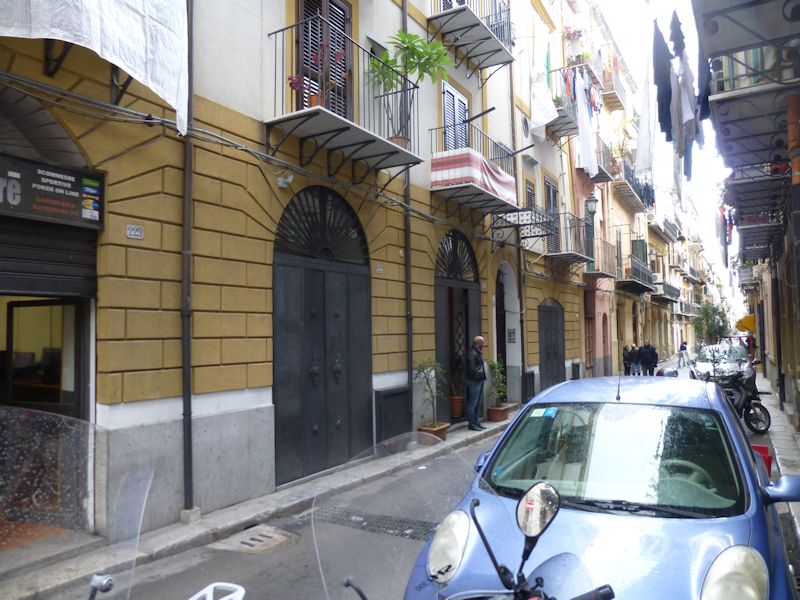
We're off! That's the front door of the excellent B+B Porta di Castro. Now we're bound for Cefalù.


 Feedback
and suggestions are welcome if positive, resented if negative, Feedback
and suggestions are welcome if positive, resented if negative,  .
All rights reserved, all wrongs avenged. Posted 17 January 2012. .
All rights reserved, all wrongs avenged. Posted 17 January 2012.
|
 Dwight Peck's personal website
Dwight Peck's personal website





































































